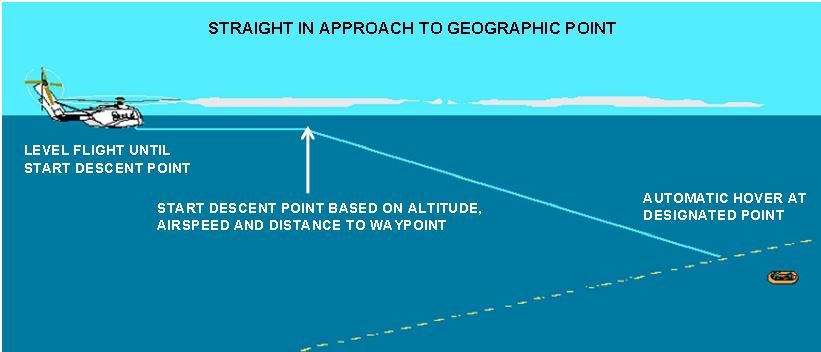The Approach to Point (ATPT) mode performs an automatic approach to a hover over a pilot selected target. The position of the target is the next waypoint in the FMS flight plan or as designated by the slew controller. To designate a waypoint, use the slew controller to position the cursor over the desired point on either NAV page and press the middle button on the slew
controller. This will put a green square and an “X” over the hooked waypoint. Subsequently, pushing the ATPT button on the MSP will initiate an approach to the hooked waypoint. The ATPT always performs a “direct to” approach and does not turn the aircraft into the wind. The pilot may choose to set an FMS waypoint prior to and down wind from the final waypoint.

When the mode is armed, the aircraft initiates an immediate turn towards the target, engages IAS and RALT, defines an approach line, and determines if there is sufficient distance between the aircraft and target to accomplish the approach. If the approach is engaged and the aircraft is too close to the target for the ATPT profile, the Flight Control Computer (FCC) will disengage ATPT. IAS and RALT will remain engaged and the aircraft will continue toward the target so that the pilot can initiate a MOT over the spot or fly the approach manually. If the distance to the target permits, the aircraft will intercept the approach line and perform a decelerating descent to arrive
at a hover over the designated coordinates.
If below the approach line when initiated, the aircraft will maintain the present altitude until it intercepts the approach line. The aircraft will maintain the present airspeed until the system commands a 1.8 knots per second deceleration to intercept the approach line at the proper speed.
If above the approach line when initiated, the aircraft will descend to intercept the line. The maximum rate of descent while intercepting the approach line is 750 FPM when above 500 feet and 500 FPM when below 500 feet. If the aircraft cannot finish the initial descent before the deceleration is scheduled to begin, the system will discontinue the approach and engage IAS and RALT.
During the “on the line” approach, the aircraft will decelerate at a nominal 1.8 knots per second and descend at 200 FPM. Above 100 feet, the maximum allowable descent rate is 400 FPM. Below 100 feet, the maximum allowable descent rate is 200 FPM. The approach will not continue if the aircraft is too close to the target to slow down or too high to descend in time. If the approach discontinues during the “on the line” portion, IAS (above 50 KIAS) or VHLD (below 50 KIAS) and RALT will automatically engage.
The ATPT will terminate in a hover over the designated coordinates. The system will initially transition to VHLD when within short range of the coordinates, and then to PHLD when directly over the coordinates in a stable hover. RALT will engage when the aircraft reaches the selected hover height. The default hover reference is 50 feet and can be adjusted from 50 to 150 feet via the HVR RA selection on either DCP.